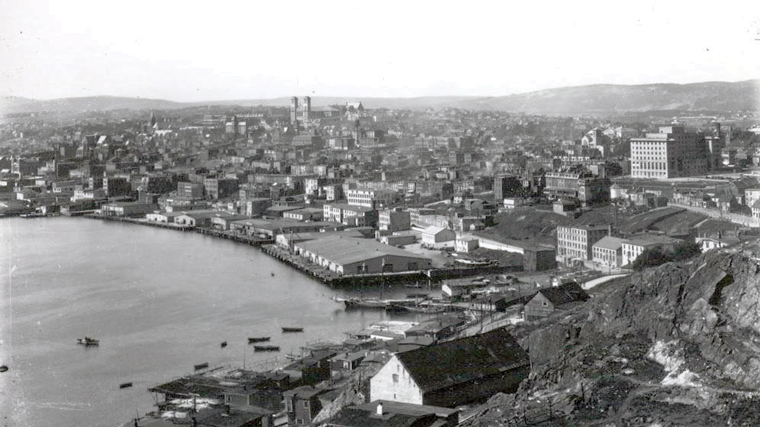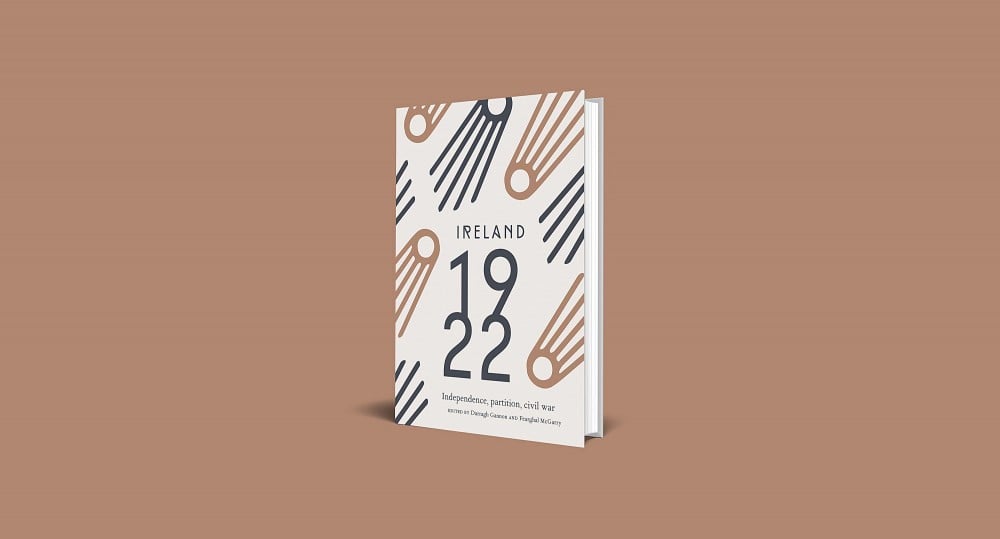13 July 1922: Jim Larkin Lectures Irish Republicans in Canada
by Patrick Mannion
On 13 July 1922 the newly established Irish Republican League of Canada (IRL) organised a lecture by Irish republican labour activist Jim Larkin at Montreal’s Auditorium Hall. Over the course of a raucous evening, a woman in the audience tore down a Union Jack and threw it on the floor—an action that spurred an angry editorial in Toronto’s ultra-loyal Mail and Empire, which was later reprinted as far away as Abbotsford, British Columbia.¹ This turbulent and controversial event demonstrated the intergenerational diaspora’s continuing, and frequently contested, esteem for their ancestral homeland in the closing stages of Ireland’s ‘global revolution’.
The transnational movement for Irish freedom had reached its zenith in mid-1921 but, beginning with the signing of the truce between British forces and the Irish Republican Army in July, and accelerated by the signing of the Anglo-Irish Treaty in December and the subsequent outbreak of civil war, the organisational networks of Irish diaspora nationalism began to break down. Although an attitude of disillusionment prevailed, individuals of Irish descent followed news from Ireland closely, and their continued, though diminished, participation in the nationalist movement reflected a wide range of opinions. In some cases, the tremendous upsurge in public expressions of Irish nationalism and identity that took place from 1919 to 1921 helped breathe new energy into intergenerational Irish cultural and associational life in 1922 and after, setting the stage for how those of Irish descent would remain connected to one another and to the ‘old land’ over the following decades.
In the United States, where republican Irish nationalism ran deep, the schism between pro- and anti-Treaty factions split the country’s foremost nationalist associations, and these divisions frequently reflected preexisting tensions within Irish American nationalism. The final, turbulent months of Éamon de Valera’s American tour of 1919 and 1920 resulted in his bitter falling out with some of the foremost leaders of the Friends of Irish Freedom, particularly John Devoy and Justice Daniel Cohalan. Despite their strong ideological republicanism, they refused to support de Valera’s stance against the Treaty, and eventually became overt supporters of the Irish Free State.² The American Association for the Recognition of the Irish Republic (AARIR), which had been established by de Valera to regain control of the mass movement for Irish independence, supported the Treaty in the early months of 1922, but by May had been taken over by anti-Treaty nationalists and continued to raise funds and lobby for the IRA ‘irregulars’. Most members did not follow the organisation down this path, and from its peak of over 700,000 in mid-1921, the AARIR’s membership had dropped to less than 14,000 by 1924.³ Smaller, more radical groups, like the MacSwiney clubs that were active in New England, tended to be more open in their opposition to the Treaty, but these remained marginal after 1922.⁴
In the dominion of Canada, circumstances were somewhat different, as notions of Catholic respectability were closely connected to expressions of imperial loyalty. Nevertheless, the pattern of a gradual breakdown of formal Irish nationalist networks was repeated. Most branches of the Self-Determination for Ireland League (SDIL), which had been established in May 1920 as an independent Canadian alternative to the Friends of Irish Freedom, shut down over the course of 1922. The overwhelming majority of Irish-Catholic Canadians supported the Treaty, and saw the Irish Free State as achieving the SDIL’s publicly stated objectives: granting the Irish people the ability to dictate their own affairs and comparable freedoms—within the structures of the British empire—to those that they enjoyed in Canada. The editor of London, Ontario’s Catholic Record noted that he disagreed with Irish American anti-Treaty contributions to the paper—specifically a weekly column on Ireland by the Donegal-born, New York-based author Seumas MacManus—stating that they failed ‘to see through Canadian eyes because they lacked Canadian experience’.⁵ The same paper also referenced the intergenerational nature of Irish Canadian engagement with Irish affairs, noting on 22 March 1922 how:
Irishmen abroad and the children of Irishmen to the third and fourth generation, whose heartstrings are bound to Ireland as no other motherland binds to herself the loving allegiance of her children, are keenly, poignantly, interested in the prospects of acceptance or rejection by the Irish people of the measure of independence guaranteed by the Anglo-Irish Treaty.⁶
As in the United States, there was considerable disillusionment among Irish Canadian nationalists as Ireland descended into civil war, but most mainstream opinion—reinforced by Catholic newspapers across the country—regarded the military actions of the Free State forces as necessary.⁷ There were, of course, exceptions. In Montreal, which had been the hotbed of republican Irish nationalism in Canada, prominent Irish Montrealer John Loye led a branch of the IRL—a resolutely anti-Treaty organisation that held public meetings throughout 1922. Overall, however, despite drawing the ire of segments of Canada’s imperially oriented newspaper press in the aftermath of Jim Larkin’s lecture, the IRL was a relatively minor organisation and attracted only a fraction of the support—and opposition—of the old SDIL.⁸
In the small, then-independent Dominion of Newfoundland, continued expressions of Irish identity in 1922 and 1923 provide an intriguing example of the ongoing construction and evolution of intergenerational ethnicity, as well as of the reconfiguration of global Irish networks that took place in the aftermath of the revolution. By the early twentieth century, the Irish community of Newfoundland’s capital and chief port, St John’s, was several generations removed from Ireland—a product of late-eighteenth and early-nineteenth century migration from the Irish south-east. Despite this significant, and growing, generational distance, nationalist associations thrived in the city in 1920 and 1921 as thousands of people attended the meetings, lectures and rallies sponsored by the local branch of the SDIL.
Following the signing of the Anglo-Irish Treaty, organised SDIL activity declined considerably, but the branch remained active until mid-1923, continuing to serve as the primary point of contact between those of Irish descent in St John’s and the broader currents of diaspora nationalism. In early 1922, for example, the branch raised funds locally to send a marathon runner, Jack Bell, to participate in the inaugural ‘Irish Race Olympics’—Aonach Tailteann—scheduled for August in Dublin. Bell arrived in Ireland only to find the meet cancelled owing to the escalating circumstances of the civil war, and returned to St John’s without competing.⁹ Similarly, it was through the structures of the SDIL that a young St John’s law student at Oxford, William J. Browne, was selected to represent Newfoundland at the 1922 Irish Race Congress. His contributions in Paris were enthusiastically reported in the local press.¹⁰
By far the most intriguing shift in the Irish-Catholic associational sphere in St John’s was the establishment of the Newfoundland Gaelic League in late 1922. This group, which had no formal affiliation with Gaelic Leagues in Ireland or elsewhere in North America, took over many of the social functions of the declining SDIL. It organised Irish language classes, put on Irish plays, sponsored lectures about Irish history, politics and literature and even had an association football team by the beginning of 1923. The League maintained a robust presence in the town until at least 1925, when references to its activities in the local press finally began to fade.¹¹
The example of the Newfoundland Gaelic League, a body comprised almost exclusively of men and women three or more generations removed from Ireland, demonstrates how the upsurge in Irish identity that accompanied the mass movement for Irish independence evolved over the subsequent years. As reports of the brutal violence of the civil war reached North America, the networks of Irish nationalism ceased to function as a unifying basis for the construction of a broader diasporic identity, as only a small proportion of the continent’s Irish ethnic communities remained involved with the movement after 1922. Ultimately, with the decline of the Friends of Irish Freedom, AARIR, SDIL and other nationalist associations, it was left to other groups, such as the Gaelic League or the transnational Ancient Order of Hibernians, to forge and promote diasporic connections into the mid-twentieth century.
Extracted from Ireland 1922 edited by Darragh Gannon and Fearghal McGarry and published by the Royal Irish Academy with support from the Department of Tourism, Culture, Arts, Gaeltacht, Sport and Media under the Decade of Centenaries 2012-2023 programme. Click here to view more articles in this series, or click the image below to visit the RIA website for more information.






















